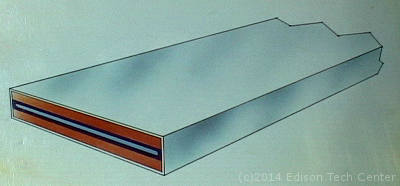Superconductors
Engineering the use of superconductive technologies to work for humankind
Superconductivity has been an exciting field for engineers over the years. They've used superconductivity in magnets to make ultra-strong magnets needed in MRI machines. They have used superconductive magnets in elevated trains (MAGLEV). Superconducting circuits allow for faster computer performance. Innovators at the Jet Propulsion Laboratory have used superconductive magnets to levitate mice in zero gravity experiments. Superconductivity has the potential to allow for very efficient high voltage long distance power transmission. The application of superconductive technology is infinite given we can figure out how to make it cost effective.
1.) Basics - basic principles
2.) Materials - common conductors and design
3.) Applications - uses of superconductors
4.) The Future
5.) Videos
1.) Basics:
Superconductivity is a phenomena of no resistance (no dissipation of resistive heating) in a material and the expulsion of magnetic fields when the material is cooled to below a certain temperature ('critical temperature').
Both resistance and electrical fields reduce efficiency in electrical conductors. In electromagnets eddy currents in the core material reduce the maximum potential strength of a magnet. By using superconductivity eddy currents can be eliminated or reduced.
If we look at superconductivity in the application of power transmission it is quite interesting.
In normal temperatures
resistance in a material like copper wire
creates heat - an unwanted product.
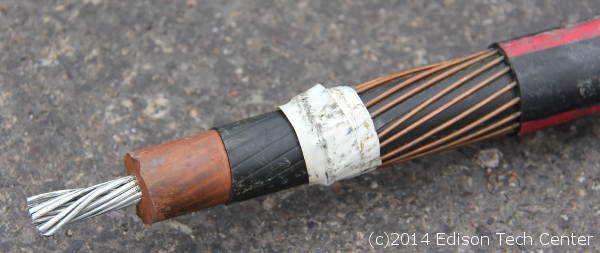
Resistivity in a wire wastes energy in normal AC power transmission.
With Superconductors there are no electric power losses.
In experiments high voltage lines are placed underground and kept super cool. More electrical power can be transmitted on the conductor and with minimal losses using superconductivity. This kind of line could be constructed hundreds of miles long to connect wind farms with the high demand areas of the grid. This would solve the age old problem of having great power sources far from cities and losing 20% or more of power in the transmission.
Learn more about resistance here.
Learn more about induction here.
2.) Materials:
Resistivity in a metallic conductor goes down as temperature drops, but you cannot achieve superconductivity simply by taking any metal and reducing it's temperature. Impurities in metals prevent superconduction from being achieved. Over the years engineers experimented and figured out how to make cables and magnet coils with special materials.
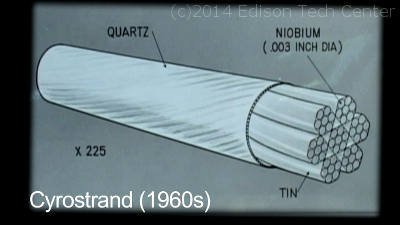 |
Above: Superconducting wire can be made into a metallic "tape" |

Above: Mark Benz, one of the pioneers of superconducting technology holds a Niobium-tin conductor used to make powerful superconducting magnets, this particular magnet design has a special cavity inside and has been manufactured and sold to many research facilities.
3.) Superconductive technology applications:
Wires/Connections:
Power Transmission
Wires
Fast digital circuits
Magnets:
The
MRI
High powered research magnets - various uses to study all sorts of things
Particle Accelerators (Physics Research) CERN, Tevatron
Radio Frequency Filters
Levitating
high-speed trains,
MAGLEV
Cardioscopes
(SQUIDS)
Rail/Coil Guns
Fault Current Limiters
Electric Motors and Generators
(Article on superconductor use in rotors)
4.) The Future
Groups around the world continue to improve the so called Low-Temperature Superconductors (LTS) and work to lower the manufacturing costs for devices. In the past several decades, people have discovered and developed High-Temperature Superconductors (HTS). HTS can exhibit superconductive characteristics at the temperature of Liquid Nitrogen (90 degrees Kelvin), and somewhat higher temperatures. LTS uses Liquid Helium at (4.2K) for LTS devices. Superconductors that operate below 77K is considered LTS. HTS is an exciting area which could reduce the cost of superconductive technologies.
5.) Videos:
Documentary: Wizards of Schenectady: Carl H. Rosner - Pioneer in Superconductors
This original Edison Tech Center documentary covers the life of Carl Rosner who was
part of a breakthrough superconductor team at General Electric. They went on to create Intermagnetics General which
produced better MRIs and are now owned by Philips. This video documentary covers a unique period and place
in engineering history.
Short Online Videos:
How the MRI Works:
Development of superconducting coils made of thin metal tape (for research magnets):
MAGLEV Train ideas:
Featured engineers in superconductivity:
Heike Kamerlingh Onnes - Discovery of superconductivity in 1911. Leiden, NL
Bell Labs:
John BardeenGeneral Electric / Intermagnetics General:
Carl H. Rosner
Ivar Giaever
Howard Hart
Mark G. Benz
W. DeSorbo
Charles Bean
John Fischer
Paul Swartz
Others Innovators of Note:
K. Tachikawa
Herbert Frohlich
David Pines
Brian Pippard
Leon Cooper
Robert Schrieffer
Georg Bednorz
K. Alex MullerCurrent Superconducting Companies and Research Organizations of Note:
Oxford Instruments
Philips
AML Superconductivity and Magnetics
Maglev
Japan Superconductor Technology Inc
Superconducting Electronics
There are a number of other Japanese companies which pioneered superconducting technology and continue to do so.
Related Topics:

Vacuum Tubes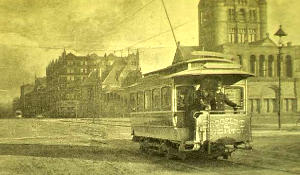
Trolleys and Light Rail
Lightning and Surge Arrestors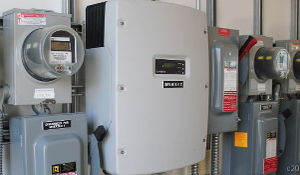
Meters and Voltage Regulators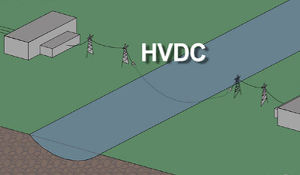
High Voltage DC Transmission
More StuffSources:
-Interview with Carl Rosner. Edison Tech Center. 2007
-Interview with Mark G. Benz. Edison Tech Center. 2008
-Interview with Howard Hart. Edison Tech Center. 2007
-Copper.org
-100 Years of Superconductivity by Horst Rogalla and Peter H. Kes


